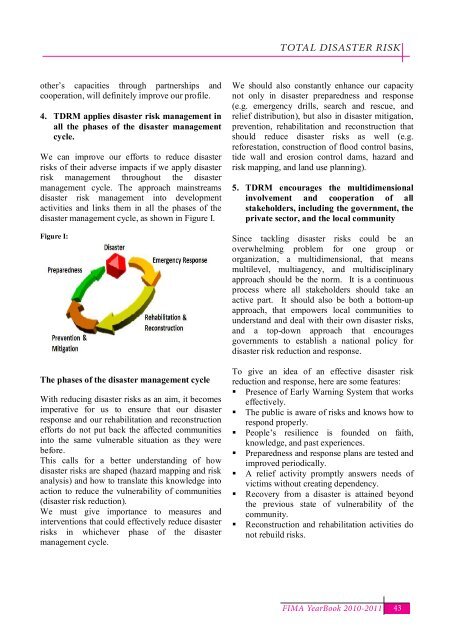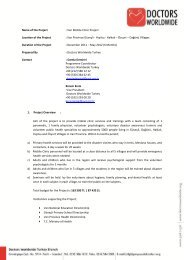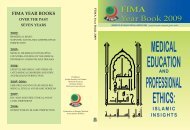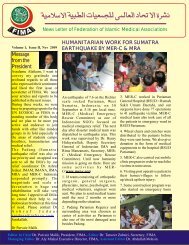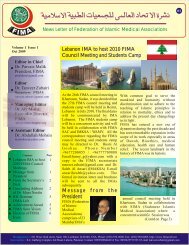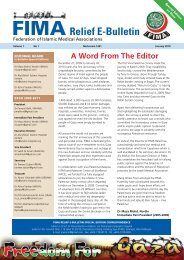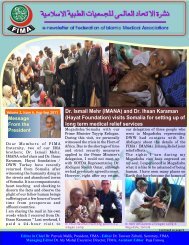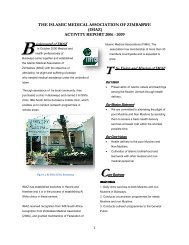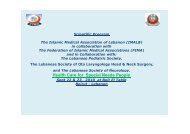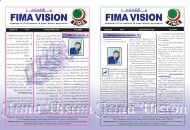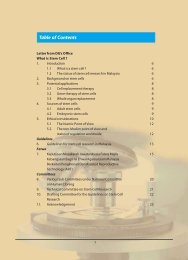FIMA Year Book 2010-2011 - Federation of Islamic Medical ...
FIMA Year Book 2010-2011 - Federation of Islamic Medical ...
FIMA Year Book 2010-2011 - Federation of Islamic Medical ...
You also want an ePaper? Increase the reach of your titles
YUMPU automatically turns print PDFs into web optimized ePapers that Google loves.
TOTAL DISASTER RISK<br />
other’s capacities through partnerships and<br />
cooperation, will definitely improve our pr<strong>of</strong>ile.<br />
4. TDRM applies disaster risk management in<br />
all the phases <strong>of</strong> the disaster management<br />
cycle.<br />
We can improve our efforts to reduce disaster<br />
risks <strong>of</strong> their adverse impacts if we apply disaster<br />
risk management throughout the disaster<br />
management cycle. The approach mainstreams<br />
disaster risk management into development<br />
activities and links them in all the phases <strong>of</strong> the<br />
disaster management cycle, as shown in Figure I.<br />
Figure I:<br />
The phases <strong>of</strong> the disaster management cycle<br />
With reducing disaster risks as an aim, it becomes<br />
imperative for us to ensure that our disaster<br />
response and our rehabilitation and reconstruction<br />
efforts do not put back the affected communities<br />
into the same vulnerable situation as they were<br />
before.<br />
This calls for a better understanding <strong>of</strong> how<br />
disaster risks are shaped (hazard mapping and risk<br />
analysis) and how to translate this knowledge into<br />
action to reduce the vulnerability <strong>of</strong> communities<br />
(disaster risk reduction).<br />
We must give importance to measures and<br />
interventions that could effectively reduce disaster<br />
risks in whichever phase <strong>of</strong> the disaster<br />
management cycle.<br />
We should also constantly enhance our capacity<br />
not only in disaster preparedness and response<br />
(e.g. emergency drills, search and rescue, and<br />
relief distribution), but also in disaster mitigation,<br />
prevention, rehabilitation and reconstruction that<br />
should reduce disaster risks as well (e.g.<br />
reforestation, construction <strong>of</strong> flood control basins,<br />
tide wall and erosion control dams, hazard and<br />
risk mapping, and land use planning).<br />
5. TDRM encourages the multidimensional<br />
involvement and cooperation <strong>of</strong> all<br />
stakeholders, including the government, the<br />
private sector, and the local community<br />
Since tackling disaster risks could be an<br />
overwhelming problem for one group or<br />
organization, a multidimensional, that means<br />
multilevel, multiagency, and multidisciplinary<br />
approach should be the norm. It is a continuous<br />
process where all stakeholders should take an<br />
active part. It should also be both a bottom-up<br />
approach, that empowers local communities to<br />
understand and deal with their own disaster risks,<br />
and a top-down approach that encourages<br />
governments to establish a national policy for<br />
disaster risk reduction and response.<br />
To give an idea <strong>of</strong> an effective disaster risk<br />
reduction and response, here are some features:<br />
• Presence <strong>of</strong> Early Warning System that works<br />
effectively.<br />
• The public is aware <strong>of</strong> risks and knows how to<br />
respond properly.<br />
• People’s resilience is founded on faith,<br />
knowledge, and past experiences.<br />
• Preparedness and response plans are tested and<br />
improved periodically.<br />
• A relief activity promptly answers needs <strong>of</strong><br />
victims without creating dependency.<br />
• Recovery from a disaster is attained beyond<br />
the previous state <strong>of</strong> vulnerability <strong>of</strong> the<br />
community.<br />
• Reconstruction and rehabilitation activities do<br />
not rebuild risks.<br />
<strong>FIMA</strong> <strong>Year</strong><strong>Book</strong> <strong>2010</strong>-<strong>2011</strong><br />
43


